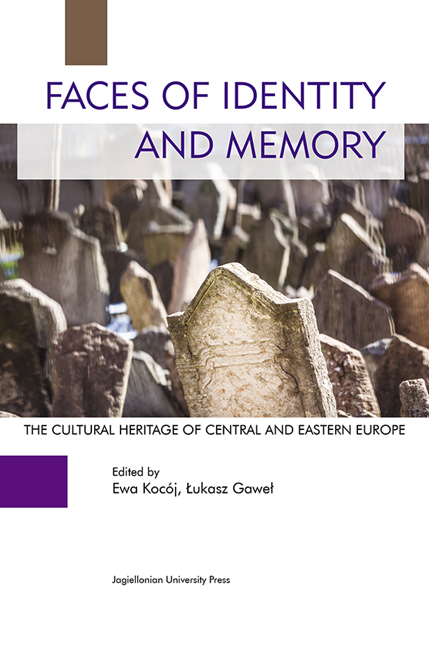 Faces of Identity and Memory
Faces of Identity and Memory Book contents
- Frontmatter
- Contents
- Introduction
- Memory and Identity. Monuments of Romanian Tangible Culture Inscribed on the UNESCO World Heritage List (a Short Presentation)
- Inventorisation and Recording of Sacral Art Objects in Lithuania in 1995–2005
- National lieux de mémoire and the European Heritage Label. Some Reflections on the Case of the Gdańsk Shipyard
- Porrajmos. Constructing Gypsy Holocaust Memory in the Recent Cinema
- The Vacuum and the Imagination of Space. The Cultural Role of the Żyznowski Publishing House
- Cultural Animation as the Art of Remembering. The Activities of the “Borderland of Arts, Cultures and Nations” Centre in Sejny
- ‘The Painted Village’ – Zalipie as an Expression of Ethnographic Tourism in the Powiśle Dąbrowskie Region of Poland
- 20th Century Theatrical Heritage: The Escape from Illusion
- Protection of Cultural Heritage. The Case of Krakow
- Managing an Artist's Legacy on the Example of Foundation for Support of Modjeska's Life and Art Research in Kraków
- Culinary Heritage as Used in the Present. Selected Elements of the Culinary Heritage Management in Contemporary Poland
Inventorisation and Recording of Sacral Art Objects in Lithuania in 1995–2005
Published online by Cambridge University Press: 10 January 2018
- Frontmatter
- Contents
- Introduction
- Memory and Identity. Monuments of Romanian Tangible Culture Inscribed on the UNESCO World Heritage List (a Short Presentation)
- Inventorisation and Recording of Sacral Art Objects in Lithuania in 1995–2005
- National lieux de mémoire and the European Heritage Label. Some Reflections on the Case of the Gdańsk Shipyard
- Porrajmos. Constructing Gypsy Holocaust Memory in the Recent Cinema
- The Vacuum and the Imagination of Space. The Cultural Role of the Żyznowski Publishing House
- Cultural Animation as the Art of Remembering. The Activities of the “Borderland of Arts, Cultures and Nations” Centre in Sejny
- ‘The Painted Village’ – Zalipie as an Expression of Ethnographic Tourism in the Powiśle Dąbrowskie Region of Poland
- 20th Century Theatrical Heritage: The Escape from Illusion
- Protection of Cultural Heritage. The Case of Krakow
- Managing an Artist's Legacy on the Example of Foundation for Support of Modjeska's Life and Art Research in Kraków
- Culinary Heritage as Used in the Present. Selected Elements of the Culinary Heritage Management in Contemporary Poland
Summary
Abstract: The article analyses the recording system of an individual typological group of cultural heritage objects (sacral art objects) in Lithuania in 1995–2005. Its main stages have been specified such as inventorisation, selection of valuable items to be protected and their legal registration. The article includes a brief introduction of the legislation that regulated the heritage protection system of Lithuania and the activities of heritage protection authorities during the discussed period.
Key words: sacral art, heritage protection, Law on Protection of Immovable Cultural Property, Law on Protection of Movable Cultural Property, inventorisation, selection of valuable items to be protected, Registers of Cultural Heritage
The term “sacral art” is used in this text as a general definition when discussing art objects (art heritage) located in churches and houses of worship of traditional religious communities. This heritage group was chosen for several reasons. It is the churches of various confessions that have preserved the largest part of Lithuanian heritage, because the elite culture of manors and residences has been practically entirely destroyed in Lithuania. This particularly abundant and valuable part of our heritage has been and still is in incomparably worse situation than the other groups of cultural heritage objects. Quite a significant portion of sacral art objects has not been identified yet. In the interwar period (in our historiography, this period is traditionally identified as the beginning of the systemic heritage protection in Lithuania), virtually no registration of such objects existed. During the war, there has been a rush to register the inventories of nationalised manor estates. To tell the truth, the inventorisation of bells in churches carried out by the Cultural Heritage Protection Authority, when German occupation government decided to put them in requisition for military needs, may be considered an exception. During Soviet times, despite a widely declared state concern for cultural heritage, its truly valuable elements – sacral art objects – were usually ignored or, by brutally changing their purpose, decontextualized and devaluated. The structural analysis of the List of Cultural Monuments of Lithuanian SSR, (by the way, intended for official use only) published in 1973 and later several times supplemented, leads to the conclusion that it has not been systematic neither territorially, nor axiologically (on the other hand, sacral art works were the dominating type in it).
Information
- Type
- Chapter
- Information
- Faces of Identity and MemoryThe Cultural Heritage of Central and Eastern Europe (Managing and Case Studies), pp. 35 - 56Publisher: Jagiellonian University PressPrint publication year: 2015